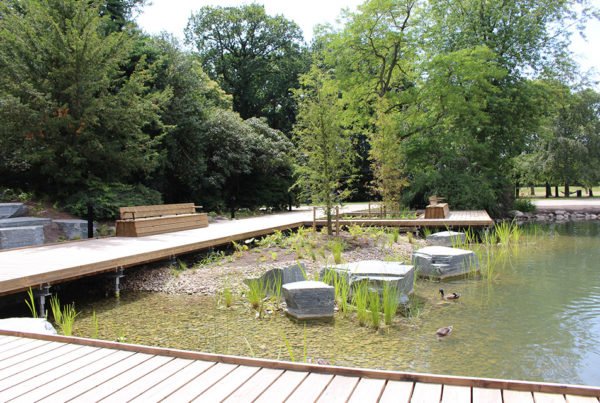REDUCE CARBON DIOXIDE EMISSIONS WITH GROUND SCREW
Sweden’s climate goal is that we should have no net emissions of greenhouse gases into the atmosphere by 2045. In order to meet the goal, we need measures that lead to a greater uptake of carbon dioxide and a reduction in greenhouse gas emissions. The cement industry is one of the major industrial sources of greenhouse gases, which means that it is important that CO2 emissions in construction projects are reduced. You can use a climate-smart solution as ground screws for a solid foundation in all places where you traditionally use cast foundations with cement and concrete. By using less cement in construction, you reduce your carbon footprint.
HOW CAN THE CONSTRUCTION INDUSTRY REDUCE CARBON DIOXIDE EMISSIONS?
In Sweden in 2018, emissions from the construction industry were 21% of Sweden’s total carbon dioxide emissions. The cement industry accounts for a significant share of carbon dioxide emissions, around eight% of emissions in Sweden. The fact that the construction industry can reduce its carbon dioxide emissions is an important aspect for us to be able to achieve our climate goals. By building with materials that have been produced in a climate-smart way, have a good service life and can be recycled, you reduce carbon dioxide emissions. You can also reduce carbon dioxide emissions by reducing the transport of materials to a construction site.
SEVERAL ENVIRONMENTAL BENEFITS WITH GROUND SCREWS
Cement is often used for ground anchoring, both for smaller and larger building projects. Ground screw also called ground screw and screw terminal works in the same way as a concrete terminal block, which means that you can anchor, for example, a noise barrier, ground system for solar cells, wooden decks, fences and conservatories. An advantage of ground screws is that you can pull them down into the ground without having to use cement. The screws are an environmentally friendly and sustainable alternative to concrete plinths. What you build lasts a long time while you do not have to compromise on technical and functional properties.
GREENHOUSE GASES AND CLIMATE CHANGE
Greenhouse gases such as carbon dioxide and methane let through the sun’s shortwave radiation. The gases absorb parts of the earth’s heat radiation, which leads to elevated levels of greenhouse gases such as carbon dioxide and methane having a warming effect. The more carbon dioxide in the atmosphere, the warmer it gets on our earth. A warmer climate means that extreme weather phenomena such as heat, rain or storms are becoming more common. An unstable climate can have catastrophic consequences in different parts of the world.
CARBON DIOXIDE EMISSIONS IN THE MANUFACTURE OF CEMENT
Cement is made by mixing finely ground limestone, sand and clay. The mixture is burned at high temperatures, around 1,450 degrees, and the carbon dioxide bound in the limestone is released into the air during the calcination process. Carbon dioxide that has been bound in the limestone for millions of years is released when the limestone is heated. About 60% of the total carbon dioxide emissions come from the calcination process, while the rest comes from the use of fuels. Fossil fuels have so far been used mostly for heating the limestone and large amounts of energy are required for the heating.
EMISSIONS DURING TRANSPORT
Transport of gravel and cement contributes to further emissions of greenhouse gases. In addition, you often need to add sand, crushed stone and large amounts of water to cement to produce concrete. Concrete pillars are awkward to transport, while ground screws are comparatively easy to transport. Approximately equal amounts of steel are used when ground screws are used as when you reinforce concrete with steel.
QUICK INSTALLATION
It is quick to install ground screws that you screw into the ground with a special tool. Unlike if you use a concrete plinth, no hole needs to be dug, which reduces carbon dioxide emissions that occur when an excavator is used. The screws are designed to work in our Nordic climate with cold winters. They basically work like a concrete plinth and you get a stable ground foundation smoothly. You can choose from a number of different heads and dimensions of the screws that are made to fit and meet different requirements that depend on the soil type and soil type. Ground screws are also adapted for different wood dimensions as well as different loads that the screws must be able to handle. The screws can withstand loads of up to five tons. Different models of ground screws can be combined so that they can easily even out different level differences.
MATERIAL RECYCLING PROVIDES LESS CARBON DIOXIDE EMISSIONS
The ground screws are made of galvanized steel and have a thin layer of zinc, which means that they can withstand at least 100 years in the ground. The screws can be reused by sorting them as metal. Steel has excellent conditions in a circular economy because it can be recycled. Today, around 90% of steel is recycled in the construction sector, which reduces the climate impact and carbon dioxide emissions. You can recycle steel as many times as you like without compromising quality. Recycled steel can replace part of the iron ore as a raw material in steel production. Carbon dioxide emissions is less than one tenth of the emissions generated in connection with iron ore-based steel production.
HOW TO REDUCE CARBON DIOXIDE EMISSIONS WITH GROUND SCREW
Carbon dioxide emissions are reduced if you choose to use ground screws. Through a more circular economy where things and materials can be reused, you reduce carbon dioxide emissions. According to calculations, ground screws emit around 60% less carbon dioxide compared to concrete plinths. Ground screws are thus a solution that reduces carbon dioxide emissions for the construction and real estate industry.





